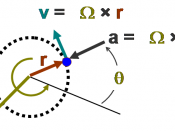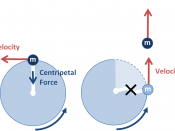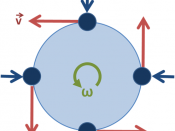INVESTIGATING CIRCULAR MOTION 11/3/04
AIM
To examine some of the factors affecting the motion of an object undergoing uniform circular motion, and then to determine the quantitative relationship between the variables of force, velocity and radius.
APPARATUS
Rubber bung Metre rule 50 gram slot masses
Glass tube 50-gram mass carrier 50-gram slot masses Metre rule
Stopwatch Sticky tape Metre rule String
THEORY
As in Jacaranda HSC Science Physics 2 p.54
In this experiment when the rubber bung is moving in a circular motion and the string it is tied to moves neither up or down a constant radius is being maintained. For this to be true the centripetal force must equal the gravitational force hence
Mv"/r = mg from this
v"/r =mg/M and v" â r therefore as v increases so does r and vice versa.
Where
m = Mass of mass carrier + masses (kg)
g = acceleration due to gravity 9.8
m/sec"
M = mass of object in motion (kg)
v = instantaneous velocity of mass (m/sec)
r = radius of circular motion (m)
METHOD
As in Jacaranda HSC Science Physics 2 p.54
However instead of measuring the time for 10 revolutions, the time for 20 revolutions was measured, this allowed more accurate results to be obtained. Furthermore the lengths given in the book were used as merely guidelines and not followed precisely also 50 and 100-gram masses were used.
RESULTS
Force (N) Radius(m) Period (20 Revolutions) (s) Orbital Velocity v m/s v"
g x 50g 1.03 19.47 6.65 44.19
g x 50g 0.83 17.02 6.12 37.55
g x 50g 0.64 14.14 5.68 32.35
g x 50g 0.37 9.94 5.2 27.04
g x 100g 1.06 16.86 7.9 62.41
g x 100g 0.82 14.4 7.15 48.702
g x 100g 0.62 12.8 6.08 37.01
g x 100g 0.44 10.2 5.42...



Motion experiment
This seems to be a well planned and nicely documented experiment examining some of the factors affecting the motion of an object undergoing uniform circular motion. I also liked your determination of the quantitative relationship between the variables of force, velocity and radius. Of course, you only needed to submit your report once.
6 out of 6 people found this comment useful.